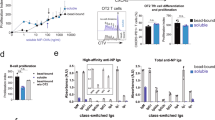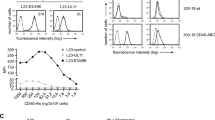Abstract
WHEREAS immunocompetent precursor B cells recognise antigenic determinants by way of specific surface receptors (an interaction which presumably initiates cell division1,2), the binding of antigen to surface receptors alone does not result in the differentiation of B cells to antibody-secreting cells. To accomplish this differentiation step a second signal is needed. This signal may be provided by T cells in the form of a soluble factor which they produce in vitro after contact with antigen3–5. Besides T cells, activated peritoneal macrophages have also been shown to produce a factor which allows B cells from athymic Nu/Nu mice to produce antibody against fowl gammaglobulin in vitro. Production of this factor is increased by addition of bacterial lipopolysaccharide (LPS) to the culture medium6. LPS itself has been shown to provide the second signal (antigen being the first) for antibody production by B cells7, but it is not clear whether the effect on antigen-reactive B cells is direct, or mediated by other cells. We report here that injection of LPS, in certain conditions in the mouse, induces the release of factors into the serum which enable B cells to produce antibody to heterologous red-cell antigen, in vitro in the absence of helper T cells. The factor is released in large quantity when LPS is injected into mice that have been primed with BCG. It is hardly, if at all, detectable in the serum of mice injected with LPS but not pretreated with BCG. Our investigation was prompted by the discovery that serum from BCG-infected mice given LPS causes acute necrosis of established tumour grafts in syngeneic mice (tumour necrosis serum, TNS)8. After partial purification, tumour-necrotising activity was shown to reside in a glycoprotein fraction (termed tumour necrosis factor, TNF) with a molecular weight of about 150,000 that migrates with the α-2-globulins9.
This is a preview of subscription content, access via your institution
Access options
Subscribe to this journal
Receive 51 print issues and online access
$199.00 per year
only $3.90 per issue
Buy this article
- Purchase on Springer Link
- Instant access to full article PDF
Prices may be subject to local taxes which are calculated during checkout
Similar content being viewed by others
References
Hunig, T., Schimpl, A., and Wecker, E., J. exp. Med., 139, 754–760 (1974).
Dutton, R. W., Transplant. Rev., 23, 66–77 (1975).
Schimpl, A. L., and Wecker, E., Nature, 237, 15–17 (1972).
Dutton, R. W., and Hunter, P., in Cellular Selection and Regulation in the Immune Response (edit. by Edelman, G. M.), 199 (Raven, New York, 1974).
Armerding, D., Kubo, R., Grey, H., and Katz, D., Proc. natn. Acad. Sci. U.S.A., 72, 4577–4581 (1975).
Schrader, J. W., J. exp. Med., 138, 1466–1480 (1973).
Watson, J., Trenkner, E., and Cohn, M., J. exp. Med., 138, 699–714 (1973).
Carswell, E. A., et al., Proc. natn. Acad. Sci. U.S.A., 72, 3666–3670 (1975).
Green, S., et al., Proc. natn. Acad. Sci. U.S.A., 73, 381–385 (1976).
Mishell, R. L., and Dutton, R. W., J. exp. Med., 126, 423–442 (1967).
Ly, I. A., and Mishell, R. I., J. Immun. Meth., 5, 289–294 (1974).
Chang-Chen, M. B., and Hirsch, J. A., Science, 176, 60–61 (1972).
Hoffmann, M. K., Hammerling, U., Simon, M., and Oettgen, H. F., J. Immun., 116, 1447–1451 (1976).
Hoffmann, M., and Kappler, J. W., J. exp. Med., 137, 721–739 (1973).
Alexander, P., and Evans, R., Nature new Biol., 232, 76–78 (1971).
Currie, G. A., and Basham, C., J. exp. Med., 142, 1600–1605 (1975).
Author information
Authors and Affiliations
Rights and permissions
About this article
Cite this article
HOFFMANN, M., GREEN, S., OLD, L. et al. Serum containing endotoxin-induced tumour necrosis factor substitutes for helper T cells. Nature 263, 416–417 (1976). https://doi.org/10.1038/263416a0
Received:
Accepted:
Issue Date:
DOI: https://doi.org/10.1038/263416a0
This article is cited by
-
The extrinsic cell death pathway and the élan mortel
Cell Death & Differentiation (2008)
-
Two distinct mechanisms of immune suppression by antibody
Nature (1978)
Comments
By submitting a comment you agree to abide by our Terms and Community Guidelines. If you find something abusive or that does not comply with our terms or guidelines please flag it as inappropriate.



